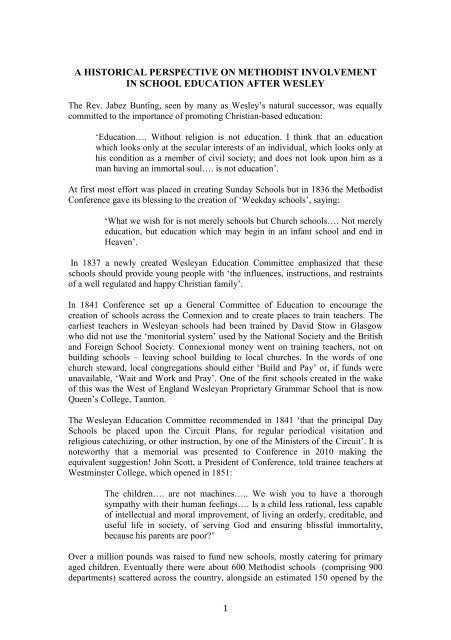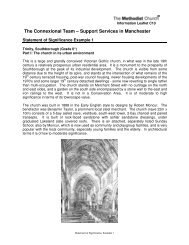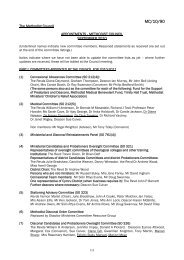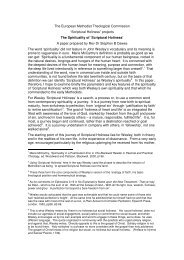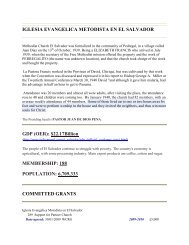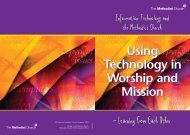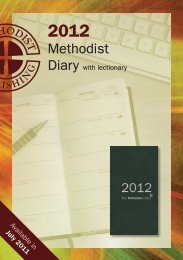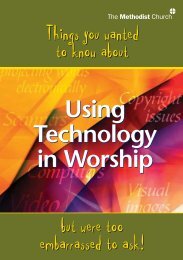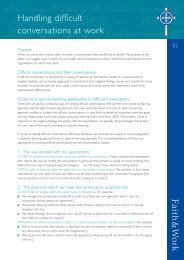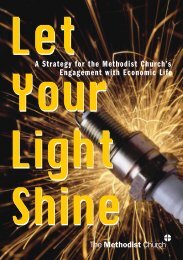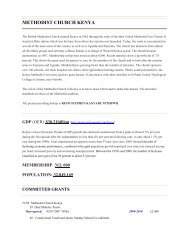a historical perspective on methodist involvement in school ...
a historical perspective on methodist involvement in school ...
a historical perspective on methodist involvement in school ...
Create successful ePaper yourself
Turn your PDF publications into a flip-book with our unique Google optimized e-Paper software.
A HISTORICAL PERSPECTIVE ON METHODIST INVOLVEMENT<br />
IN SCHOOL EDUCATION AFTER WESLEY<br />
The Rev. Jabez Bunt<strong>in</strong>g, seen by many as Wesley’s natural successor, was equally<br />
committed to the importance of promot<strong>in</strong>g Christian-based educati<strong>on</strong>:<br />
‘Educati<strong>on</strong>…. Without religi<strong>on</strong> is not educati<strong>on</strong>. I th<strong>in</strong>k that an educati<strong>on</strong><br />
which looks <strong>on</strong>ly at the secular <strong>in</strong>terests of an <strong>in</strong>dividual, which looks <strong>on</strong>ly at<br />
his c<strong>on</strong>diti<strong>on</strong> as a member of civil society; and does not look up<strong>on</strong> him as a<br />
man hav<strong>in</strong>g an immortal soul…. is not educati<strong>on</strong>’.<br />
At first most effort was placed <strong>in</strong> creat<strong>in</strong>g Sunday Schools but <strong>in</strong> 1836 the Methodist<br />
C<strong>on</strong>ference gave its bless<strong>in</strong>g to the creati<strong>on</strong> of ‘Weekday <strong>school</strong>s’, say<strong>in</strong>g:<br />
‘What we wish for is not merely <strong>school</strong>s but Church <strong>school</strong>s…. Not merely<br />
educati<strong>on</strong>, but educati<strong>on</strong> which may beg<strong>in</strong> <strong>in</strong> an <strong>in</strong>fant <strong>school</strong> and end <strong>in</strong><br />
Heaven’.<br />
In 1837 a newly created Wesleyan Educati<strong>on</strong> Committee emphasized that these<br />
<strong>school</strong>s should provide young people with ‘the <strong>in</strong>fluences, <strong>in</strong>structi<strong>on</strong>s, and restra<strong>in</strong>ts<br />
of a well regulated and happy Christian family’.<br />
In 1841 C<strong>on</strong>ference set up a General Committee of Educati<strong>on</strong> to encourage the<br />
creati<strong>on</strong> of <strong>school</strong>s across the C<strong>on</strong>nexi<strong>on</strong> and to create places to tra<strong>in</strong> teachers. The<br />
earliest teachers <strong>in</strong> Wesleyan <strong>school</strong>s had been tra<strong>in</strong>ed by David Stow <strong>in</strong> Glasgow<br />
who did not use the ‘m<strong>on</strong>itorial system’ used by the Nati<strong>on</strong>al Society and the British<br />
and Foreign School Society. C<strong>on</strong>nexi<strong>on</strong>al m<strong>on</strong>ey went <strong>on</strong> tra<strong>in</strong><strong>in</strong>g teachers, not <strong>on</strong><br />
build<strong>in</strong>g <strong>school</strong>s – leav<strong>in</strong>g <strong>school</strong> build<strong>in</strong>g to local churches. In the words of <strong>on</strong>e<br />
church steward, local c<strong>on</strong>gregati<strong>on</strong>s should either ‘Build and Pay’ or, if funds were<br />
unavailable, ‘Wait and Work and Pray’. One of the first <strong>school</strong>s created <strong>in</strong> the wake<br />
of this was the West of England Wesleyan Proprietary Grammar School that is now<br />
Queen’s College, Taunt<strong>on</strong>.<br />
The Wesleyan Educati<strong>on</strong> Committee recommended <strong>in</strong> 1841 ‘that the pr<strong>in</strong>cipal Day<br />
Schools be placed up<strong>on</strong> the Circuit Plans, for regular periodical visitati<strong>on</strong> and<br />
religious catechiz<strong>in</strong>g, or other <strong>in</strong>structi<strong>on</strong>, by <strong>on</strong>e of the M<strong>in</strong>isters of the Circuit’. It is<br />
noteworthy that a memorial was presented to C<strong>on</strong>ference <strong>in</strong> 2010 mak<strong>in</strong>g the<br />
equivalent suggesti<strong>on</strong>! John Scott, a President of C<strong>on</strong>ference, told tra<strong>in</strong>ee teachers at<br />
Westm<strong>in</strong>ster College, which opened <strong>in</strong> 1851:<br />
The children…. are not mach<strong>in</strong>es….. We wish you to have a thorough<br />
sympathy with their human feel<strong>in</strong>gs…. Is a child less rati<strong>on</strong>al, less capable<br />
of <strong>in</strong>tellectual and moral improvement, of liv<strong>in</strong>g an orderly, creditable, and<br />
useful life <strong>in</strong> society, of serv<strong>in</strong>g God and ensur<strong>in</strong>g blissful immortality,<br />
because his parents are poor’<br />
Over a milli<strong>on</strong> pounds was raised to fund new <strong>school</strong>s, mostly cater<strong>in</strong>g for primary<br />
aged children. Eventually there were about 600 Methodist <strong>school</strong>s (compris<strong>in</strong>g 900<br />
departments) scattered across the country, al<strong>on</strong>gside an estimated 150 opened by the<br />
1
United Free Churches, Primitive Methodist C<strong>on</strong>nexi<strong>on</strong>, Methodist New C<strong>on</strong>nexi<strong>on</strong>,<br />
etc. These other branches of Methodism shared the same enthusiasm for educati<strong>on</strong>.<br />
The Bible Christians, for example, had created the <strong>school</strong> that later developed <strong>in</strong>to<br />
Shebbear College as early as 1832.<br />
A str<strong>on</strong>g Methodist <strong>in</strong>put <strong>in</strong>to teacher tra<strong>in</strong><strong>in</strong>g was ma<strong>in</strong>ta<strong>in</strong>ed up until the early 1990s<br />
largely through Westm<strong>in</strong>ster College and Southlands College, which was created <strong>in</strong><br />
1872. However, this important c<strong>on</strong>tributi<strong>on</strong> to educati<strong>on</strong> was then largely allowed to<br />
disappear because the colleges were <strong>in</strong>creas<strong>in</strong>gly subsumed <strong>in</strong>to larger organizati<strong>on</strong>s.<br />
Southlands College was <strong>on</strong>e of four colleges that merged to form the Roehampti<strong>on</strong><br />
Institute <strong>in</strong> 1975 and <strong>in</strong> 2004 this became Roehampt<strong>on</strong> University. What was<br />
Southlands now largely houses the University’s School of Bus<strong>in</strong>ess and Social<br />
Sciences together with the Music secti<strong>on</strong> of the School of Arts. Westm<strong>in</strong>ster College<br />
entered <strong>in</strong>to an academic partnership with the University of Oxford <strong>in</strong> 1992, allow<strong>in</strong>g<br />
its students to read for degrees of the University, and then, <strong>in</strong> 1999, it was<br />
c<strong>on</strong>troversially handed over to Oxford Brookes University, who now run it as the<br />
Westm<strong>in</strong>ster Institute of Educati<strong>on</strong>.<br />
The decade 1858 to 1868 saw three Royal Commissi<strong>on</strong>s <strong>in</strong>to educati<strong>on</strong> that resulted<br />
<strong>in</strong> a move towards creat<strong>in</strong>g a nati<strong>on</strong>al educati<strong>on</strong> system. The 1864 Clarend<strong>on</strong><br />
Commissi<strong>on</strong> <strong>in</strong>to the n<strong>in</strong>e great public <strong>school</strong>s and the 1868 Commissi<strong>on</strong> <strong>in</strong>to<br />
endowed <strong>school</strong>s both c<strong>on</strong>cluded that sec<strong>on</strong>dary (then called higher) educati<strong>on</strong> might<br />
benefit by look<strong>in</strong>g at the style of educati<strong>on</strong> offered <strong>in</strong> the best <strong>in</strong>dependent <strong>school</strong>s.<br />
The Methodist C<strong>on</strong>ference decided to resp<strong>on</strong>d <strong>in</strong> two ways. First, it improved the<br />
quality of educati<strong>on</strong> offered to the s<strong>on</strong>s of its m<strong>in</strong>isters by mak<strong>in</strong>g reforms at<br />
K<strong>in</strong>gswood and Woodhouse Grove (which had been opened <strong>in</strong> 1812) and, at the same<br />
time, it opened three new <strong>school</strong>s for the daughters of m<strong>in</strong>isters (Five Elms,<br />
Beechholme and Tr<strong>in</strong>ity Hall). Sec<strong>on</strong>dly, follow<strong>in</strong>g the government’s decisi<strong>on</strong> <strong>in</strong><br />
1871 to end the ban <strong>on</strong> N<strong>on</strong>c<strong>on</strong>formists attend<strong>in</strong>g Oxford and Cambridge, it created<br />
the Leys School <strong>in</strong> Cambridge <strong>in</strong> 1877 as Methodism’s answer to Rugby,<br />
Marlborough and the other great Anglican board<strong>in</strong>g <strong>school</strong>s because:<br />
‘The future of our Church lies with its youth; and if the more <strong>in</strong>telligent and<br />
better educated of these should be gradually drafted off <strong>in</strong>to other<br />
[religious] communities the usefulness, if not the existence of Methodism,<br />
would be seriously imperiled’.<br />
A significant number of other sec<strong>on</strong>dary board<strong>in</strong>g <strong>school</strong>s were created <strong>in</strong> the wake of<br />
this, <strong>in</strong>clud<strong>in</strong>g Truro College, Rydal and Penrhos, Wycliffe College, the East Anglian<br />
<strong>school</strong> (now Culford), Edgehill, Queenswood, and the two Kent Colleges <strong>in</strong><br />
Canterbury and Pembury. Similarly, the United Metodist C<strong>on</strong>nexi<strong>on</strong> opened Ashville<br />
College <strong>in</strong> 1877. This period also saw the creati<strong>on</strong> of Cliff College <strong>in</strong> 1883 as a<br />
tra<strong>in</strong><strong>in</strong>g place for lay preachers and evangelists.<br />
James Harris<strong>on</strong> Rigg, the first lead<strong>in</strong>g Pr<strong>in</strong>cipal of Westm<strong>in</strong>ster College, encouraged<br />
Methodism to th<strong>in</strong>k that the state educati<strong>on</strong> system that was be<strong>in</strong>g created after 1870<br />
would not offer an entire answer to meet<strong>in</strong>g the religious needs of children. He argued<br />
that the state’s <strong>in</strong>terest was essentially utilitarian whereas the Methodist <strong>in</strong>terest was<br />
more c<strong>on</strong>cerned about ‘moral and religious standards’ and <strong>in</strong> generat<strong>in</strong>g ‘wisdom’<br />
rather than just knowledge. At the C<strong>on</strong>ference of 1885, he po<strong>in</strong>ted out to the<br />
2
members that if they could not afford to keep up day <strong>school</strong>s, then they could not<br />
afford to keep up Methodism.<br />
The Wesleyans were very divided about whether to keep their day <strong>school</strong>s, as was<br />
evident from the heated debates <strong>in</strong> 1889 and 1890. Those who followed Rigg thought<br />
that reta<strong>in</strong><strong>in</strong>g Methodist <strong>school</strong>s was the <strong>on</strong>ly reliable way of ensur<strong>in</strong>g n<strong>on</strong>denom<strong>in</strong>ati<strong>on</strong>al<br />
Bible teach<strong>in</strong>g. They were a protective barrier for Methodists aga<strong>in</strong>st<br />
Anglican supremacy <strong>in</strong> <strong>school</strong> provisi<strong>on</strong>. While most <strong>school</strong> boards did provide<br />
religious <strong>in</strong>structi<strong>on</strong>, it was not obligatory, and, <strong>in</strong> the villages that were dom<strong>in</strong>ated by<br />
Anglican <strong>in</strong>terests, teach<strong>in</strong>g could not be guaranteed to be undenom<strong>in</strong>ati<strong>on</strong>al when the<br />
teachers were appo<strong>in</strong>ted by the board. Another group followed the th<strong>in</strong>k<strong>in</strong>g of Hugh<br />
Price Hughes, who argued that the competiti<strong>on</strong> aga<strong>in</strong>st the Church of England could<br />
not be w<strong>on</strong> and so it was better to end the denom<strong>in</strong>ati<strong>on</strong>al system. The universal<br />
provisi<strong>on</strong> of unsectarian board <strong>school</strong>s offered the best protecti<strong>on</strong> of Methodist<br />
<strong>in</strong>terests.<br />
In 1891 the Methodist Church decided its policy would be to support <strong>school</strong> boards<br />
everywhere, but, at the same time, to ma<strong>in</strong>ta<strong>in</strong> its exist<strong>in</strong>g <strong>school</strong>s and tra<strong>in</strong><strong>in</strong>g<br />
colleges as l<strong>on</strong>g as there were other denom<strong>in</strong>ati<strong>on</strong>al <strong>school</strong>s. The next year circuits<br />
were warned aga<strong>in</strong>st transferr<strong>in</strong>g their <strong>school</strong>s to their <strong>school</strong> board. Not all circuits<br />
followed this advice but by the time of the 1902 Educati<strong>on</strong> Act there were still about<br />
350 Wesleyan <strong>school</strong>s and nearly 50 n<strong>on</strong>-Wesleyan. In 1903 the Methodist Church<br />
created the Board of Management for its board<strong>in</strong>g <strong>school</strong>s. Many felt it was important<br />
to ma<strong>in</strong>ta<strong>in</strong> these <strong>school</strong>s because of their potential to offer an educati<strong>on</strong> that was<br />
more dist<strong>in</strong>ctively Christian <strong>in</strong> nature. In 1928 the Wesleyan Educati<strong>on</strong> Committee<br />
voiced this:<br />
‘Sec<strong>on</strong>dary day <strong>school</strong>s under the Local Educati<strong>on</strong> Authorities cannot<br />
provide to the same extent for that development based <strong>on</strong> religious teach<strong>in</strong>g,<br />
pers<strong>on</strong>al c<strong>on</strong>tact, and <strong>in</strong>fluence such as, <strong>in</strong> the op<strong>in</strong>i<strong>on</strong> of the Churches<br />
generally, is possible <strong>in</strong> a board<strong>in</strong>g <strong>school</strong>.’<br />
Even at this stage new Methodist <strong>school</strong>s were still be<strong>in</strong>g occasi<strong>on</strong>ally created. What<br />
is now Farr<strong>in</strong>gt<strong>on</strong>s, for example, was opened <strong>in</strong> 1911 to replace Laleham Lodge,<br />
which had been created <strong>in</strong> the 1850s by Hannah Pipe, a pi<strong>on</strong>eer of female educati<strong>on</strong>.<br />
The 1902 Educati<strong>on</strong> Act empowered the newly created local educati<strong>on</strong> authorities to<br />
start provid<strong>in</strong>g sec<strong>on</strong>dary <strong>school</strong>s either by pay<strong>in</strong>g for places at exist<strong>in</strong>g <strong>in</strong>dependent<br />
grammar <strong>school</strong>s or by creat<strong>in</strong>g new <strong>school</strong>s. At the same time the f<strong>in</strong>ances of the<br />
elementary <strong>school</strong>s were set <strong>on</strong> a firmer foot<strong>in</strong>g as all their runn<strong>in</strong>g costs were<br />
covered by the LEA, leav<strong>in</strong>g the managers to look after the build<strong>in</strong>g. Unfortunately,<br />
as expectati<strong>on</strong>s of elementary educati<strong>on</strong> <strong>in</strong>creased, so demands for larger and better<br />
build<strong>in</strong>gs were raised. This meant that <strong>in</strong>creas<strong>in</strong>g numbers of circuits took the view<br />
that either their elementary <strong>school</strong>s could not be brought up to the new standards or<br />
they lacked the f<strong>in</strong>ance to fund the necessary changes. This led to a further decl<strong>in</strong>e <strong>in</strong><br />
the number of Methodist <strong>school</strong>s over the next thirty years so that by the time of<br />
Methodist Uni<strong>on</strong> there were <strong>on</strong>ly 118 Wesleyan, 7 United Methodist and 4 Primitive<br />
day <strong>school</strong>s rema<strong>in</strong><strong>in</strong>g.<br />
In preparati<strong>on</strong> for Methodist Uni<strong>on</strong> <strong>in</strong> 1932, the church’s educati<strong>on</strong> policy was spelt<br />
3
out: universal publicly provided and c<strong>on</strong>trolled Christian unsectarian <strong>school</strong>s with<strong>in</strong> a<br />
reas<strong>on</strong>able distance of every family was the goal. Until then it was vital to ma<strong>in</strong>ta<strong>in</strong><br />
exist<strong>in</strong>g Methodist day <strong>school</strong>s <strong>in</strong> places where it was not possible to establish<br />
Christian unsectarian <strong>school</strong>s. No Methodist <strong>school</strong> could be closed or transferred<br />
without the c<strong>on</strong>sent of the C<strong>on</strong>nexi<strong>on</strong>. The focus was primarily at reta<strong>in</strong><strong>in</strong>g <strong>school</strong>s at<br />
elementary level so the last Methodist sec<strong>on</strong>dary day <strong>school</strong> was closed <strong>in</strong> 1936,<br />
leav<strong>in</strong>g <strong>on</strong>ly the board<strong>in</strong>g <strong>school</strong>s to offer Methodist educati<strong>on</strong> at that level.<br />
The slow but <strong>in</strong>exorable decl<strong>in</strong>e <strong>in</strong> the number of Methodist day <strong>school</strong>s <strong>in</strong> the first<br />
part of the twentieth century was offset by greater attenti<strong>on</strong> to Sunday Schools. In<br />
1907 Westhill College was created to tra<strong>in</strong> Sunday School teachers and youth leaders.<br />
It diversified <strong>in</strong>to other educati<strong>on</strong>al and theological courses and <strong>in</strong> 1922 became the<br />
founder member of the Selly Oak Federati<strong>on</strong> of Colleges, which comb<strong>in</strong>ed Methodist<br />
educati<strong>on</strong>al efforts with those of the Baptists, Quakers, and United Reformed Church.<br />
Its ma<strong>in</strong> focus for a c<strong>on</strong>siderable time became, like Westm<strong>in</strong>ster and Southlands,<br />
tra<strong>in</strong><strong>in</strong>g for <strong>school</strong> teachers. In 1999 it became part of Birm<strong>in</strong>gham University and its<br />
dist<strong>in</strong>ctive Methodist ethos has s<strong>in</strong>ce been largely lost. S<strong>in</strong>ce 2001 Westhill has been<br />
merged with Birm<strong>in</strong>gham’s School of Educati<strong>on</strong>.<br />
Most Christian denom<strong>in</strong>ati<strong>on</strong>s assumed that the teach<strong>in</strong>g of Christianity would<br />
automatically be part of the curriculum <strong>in</strong> the new state <strong>school</strong>s. In 1941 the<br />
Methodist Church jo<strong>in</strong>ed with the other Free Churches and the Church of England <strong>in</strong><br />
endors<strong>in</strong>g that the state should provide for all children to be given a Christian<br />
educati<strong>on</strong>, that all <strong>school</strong>s should start the day with an act of Christian worship, and<br />
that religious <strong>in</strong>structi<strong>on</strong> should be timetabled with<strong>in</strong> every <strong>school</strong>’s curriculum and<br />
<strong>in</strong>spected by HMI. They also agreed that religious <strong>in</strong>structi<strong>on</strong> should be an opti<strong>on</strong>al<br />
subject <strong>in</strong> all teacher tra<strong>in</strong><strong>in</strong>g colleges. Backed by the Christian Educati<strong>on</strong> Movement,<br />
the churches successfully lobbied government and, as a result, religious <strong>in</strong>structi<strong>on</strong><br />
and religious worship both featured str<strong>on</strong>gly <strong>in</strong> the 1944 Educati<strong>on</strong> Act. The<br />
Methodist Church welcomed this:<br />
‘We have always believed that the great simplicities of the Christian<br />
religi<strong>on</strong> should form the basis of English educati<strong>on</strong> and have l<strong>on</strong>g hoped<br />
that <strong>in</strong> this field denom<strong>in</strong>ati<strong>on</strong>al differences might be forgotten’.<br />
After the Sec<strong>on</strong>d World War the Methodist Church str<strong>on</strong>gly supported the<br />
development of Agreed Syllabuses for the use of county and voluntary c<strong>on</strong>trolled<br />
<strong>school</strong>s. Co-operati<strong>on</strong> between Church and State meant that the Methodist Church<br />
also welcomed its board<strong>in</strong>g <strong>school</strong>s participat<strong>in</strong>g <strong>in</strong> the Direct Grant system and the<br />
later Assisted Places scheme. In 1965 the Headmaster of K<strong>in</strong>gswood told the Public<br />
Schools Commissi<strong>on</strong>:<br />
‘[Many Methodist <strong>in</strong>dependent <strong>school</strong>s would] will<strong>in</strong>gly accept some form<br />
of <strong>in</strong>tegrati<strong>on</strong> <strong>in</strong>to the state system provided they could preserve that<br />
<strong>in</strong>dependence and freedom which are so valuable and precious <strong>in</strong><br />
educati<strong>on</strong>’.<br />
A belief <strong>in</strong> reta<strong>in</strong><strong>in</strong>g <strong>school</strong>s that had sufficient <strong>in</strong>dependence to be str<strong>on</strong>gly Christian<br />
<strong>in</strong> their ethos expla<strong>in</strong>s not <strong>on</strong>ly the Methodist Church’s retenti<strong>on</strong> of its board<strong>in</strong>g<br />
<strong>school</strong>s but also the decisi<strong>on</strong> to c<strong>on</strong>t<strong>in</strong>ue support<strong>in</strong>g the few rema<strong>in</strong><strong>in</strong>g Methodist<br />
4
primary <strong>school</strong>s (mostly <strong>in</strong> the north-west) that had not been handed over entirely to<br />
the local authorities. In 1955 it was agreed to open a Church of England and<br />
Methodist voluntary c<strong>on</strong>trolled <strong>school</strong> <strong>in</strong> Caistor to replace the two small village<br />
church <strong>school</strong>s. It opened <strong>in</strong> 1957 and was followed ten years later by the first<br />
voluntary aided <strong>school</strong> at Br<strong>in</strong>scall <strong>in</strong> Lancashire which replaced five small village<br />
<strong>school</strong>s. Other new ecumenical <strong>school</strong>s followed, <strong>in</strong>clud<strong>in</strong>g Christ the Sower <strong>in</strong><br />
Milt<strong>on</strong> Keynes which was a jo<strong>in</strong>t venture by four churches. As a c<strong>on</strong>sequence there<br />
are now 65 Methodist ma<strong>in</strong>ta<strong>in</strong>ed primary <strong>school</strong>s, many <strong>in</strong> areas of social<br />
deprivati<strong>on</strong>, and these are located <strong>in</strong> fifteen districts across the C<strong>on</strong>nexi<strong>on</strong>. Most (but<br />
sadly not all) are supported by local churches and circuits. M<strong>in</strong>isters exercise pastoral<br />
care and lead worship, volunteers assist <strong>in</strong> the classroom and act as governors, and<br />
c<strong>on</strong>gregati<strong>on</strong>s help fund-raise.<br />
In 1971 the Board of Management of Methodist Residential Schools commissi<strong>on</strong>ed<br />
the Laybourne Report <strong>in</strong>to the future of its <strong>in</strong>dependent <strong>school</strong>s because of c<strong>on</strong>cerns<br />
raised at their fee-pay<strong>in</strong>g nature. The Report accepted that some children had a<br />
board<strong>in</strong>g need that could not be met by day <strong>school</strong>s and described the Methodist<br />
<strong>school</strong>s as ‘friendly, humane <strong>in</strong>stituti<strong>on</strong>s <strong>in</strong> which there is a real and largely<br />
successful attempt to translate Christian values <strong>in</strong>to everyday liv<strong>in</strong>g’. It c<strong>on</strong>cluded:<br />
‘It is vitally important to reta<strong>in</strong> <strong>school</strong>s <strong>in</strong> which the Church can<br />
dem<strong>on</strong>strate what is meant by a Christian educati<strong>on</strong>’.<br />
Such a statement arose because it was becom<strong>in</strong>g obvious by then that the state system<br />
was becom<strong>in</strong>g far less committed to reta<strong>in</strong><strong>in</strong>g a Christian emphasis with<strong>in</strong> its <strong>school</strong>s,<br />
partly because of the <strong>in</strong>creas<strong>in</strong>gly secular nature of society and partly because<br />
immigrati<strong>on</strong> was creat<strong>in</strong>g a situati<strong>on</strong> <strong>in</strong> which some <strong>school</strong>s c<strong>on</strong>ta<strong>in</strong>ed many children<br />
from other faiths. As a c<strong>on</strong>sequence many denom<strong>in</strong>ati<strong>on</strong>s were recogniz<strong>in</strong>g that it was<br />
becom<strong>in</strong>g essential to preserve those <strong>school</strong>s that still had a truly Christian foundati<strong>on</strong><br />
and ethos.<br />
In 1977, follow<strong>in</strong>g the aboliti<strong>on</strong> of the Direct Grant system, the Methodist C<strong>on</strong>ference<br />
staged a major debate <strong>on</strong> whether it should allow its board<strong>in</strong>g <strong>school</strong>s to move to full<br />
<strong>in</strong>dependence or whether it should close them. The decisi<strong>on</strong> was to reta<strong>in</strong> them<br />
because they were a means of offer<strong>in</strong>g an educati<strong>on</strong> that was dist<strong>in</strong>ctively Christian<br />
and their presence gave the Church a c<strong>on</strong>t<strong>in</strong>ued voice <strong>in</strong> any nati<strong>on</strong>al debate <strong>on</strong> <strong>school</strong><br />
educati<strong>on</strong>. This decisi<strong>on</strong> was re<strong>in</strong>forced <strong>in</strong> 1988 when C<strong>on</strong>ference stated:<br />
‘The use of the educati<strong>on</strong>al system for political ends is widespread<br />
throughout the world, and a future government might not <strong>on</strong>ly remove<br />
religious educati<strong>on</strong> from the special positi<strong>on</strong> it now enjoys <strong>in</strong> the <strong>school</strong>s<br />
under its c<strong>on</strong>trol; it might also forbid the direct teach<strong>in</strong>g of a specifically<br />
Christian theology…. or <strong>in</strong>fuse the teach<strong>in</strong>g of a n<strong>on</strong>-Christian theology.<br />
Aga<strong>in</strong>st this possibility an effective Christian witness able to resist pressure<br />
from the State needs to be ma<strong>in</strong>ta<strong>in</strong>ed <strong>in</strong> the field of educati<strong>on</strong>; without it<br />
the Christian case for belief <strong>in</strong> God and Christ, for freedom of thought,<br />
speech and religi<strong>on</strong>, and for <strong>in</strong>dividual human rights, will be gravely<br />
weakened.’<br />
By this stage, of course, it was obvious that the state was no l<strong>on</strong>ger prepared to give<br />
5
any priority to Christianity with<strong>in</strong> what were now be<strong>in</strong>g called ‘community <strong>school</strong>s’.<br />
The religious curriculum at both primary and sec<strong>on</strong>dary level had l<strong>on</strong>g ceased to<br />
focus just <strong>on</strong> Christianity and it was prohibited for teachers to promote bel<strong>on</strong>g<strong>in</strong>g to a<br />
particular faith. Only those <strong>school</strong>s that had were l<strong>in</strong>ked to a Christian denom<strong>in</strong>ati<strong>on</strong><br />
were free to give greater emphasis to Christianity. Not surpris<strong>in</strong>gly, <strong>in</strong> 1998 the<br />
Essence of Educati<strong>on</strong> report said the state should not be permitted a ‘m<strong>on</strong>opoly <strong>on</strong><br />
educati<strong>on</strong>’ and, as far as its board<strong>in</strong>g <strong>school</strong>s were c<strong>on</strong>cerned, the Church ‘should not<br />
surrender the foothold which we have <strong>in</strong> the <strong>in</strong>dependent sector’ as l<strong>on</strong>g as the<br />
<strong>school</strong>s rema<strong>in</strong>ed ‘viable, self-support<strong>in</strong>g <strong>in</strong>stituti<strong>on</strong>s’ (i.e. expected no f<strong>in</strong>ancial<br />
<strong>in</strong>put from the Church). To make clear that Methodist <strong>school</strong>s were not divisive, the<br />
Board of Management committed itself to offer<strong>in</strong>g ‘a significant c<strong>on</strong>tributi<strong>on</strong> to<br />
build<strong>in</strong>g a society <strong>in</strong> which knowledge, understand<strong>in</strong>g and tolerance predom<strong>in</strong>ate over<br />
ignorance, prejudice and discrim<strong>in</strong>ati<strong>on</strong>.’<br />
Support for the <strong>in</strong>dependent <strong>school</strong>s was matched by a grow<strong>in</strong>g recogniti<strong>on</strong> <strong>in</strong> some<br />
quarters that the Methodist Church should more fully endorse the work of its<br />
rema<strong>in</strong><strong>in</strong>g Methodist primary <strong>school</strong>s. These are, of course, very few <strong>in</strong> number<br />
compared to the large number of <strong>school</strong>s run by the Church of England (which<br />
c<strong>on</strong>ta<strong>in</strong> 18.6% of all primary pupils and 5.8% of all sec<strong>on</strong>dary pupils) or the Catholic<br />
Church. However, they are part of a Christian <strong><strong>in</strong>volvement</strong> <strong>in</strong> educati<strong>on</strong> whose<br />
collective impact has not g<strong>on</strong>e unnoticed. It is generally accepted that they often<br />
(though not always) offer a superior educati<strong>on</strong> to the more secular community<br />
<strong>school</strong>s. Chris Woodhead, ex-Chief Inspector of Schools 1994-2000, attributed this<br />
to ‘their commitment to a comm<strong>on</strong> core of values’ that made them have a deeper<br />
understand<strong>in</strong>g of what ultimately matters and therefore less likely to resp<strong>on</strong>d to the<br />
latest politically driven educati<strong>on</strong>al fad. As Secretary of State for Educati<strong>on</strong> and<br />
Employment, David Blunkett expressed a wish to ‘bottle their ethos’.<br />
In 2006 ‘Every Child Matters – All Precious <strong>in</strong> God’s Sight’ was produced to support<br />
Methodist church <strong>school</strong>s deliver educati<strong>on</strong> ‘from a Christian <str<strong>on</strong>g>perspective</str<strong>on</strong>g>’ <strong>in</strong> which<br />
each child is valued, has access to learn<strong>in</strong>g excellence, and enjoys holistic educati<strong>on</strong><br />
<strong>in</strong> a socially cohesive and <strong>in</strong>tegrated Christian community’. It stated that support<strong>in</strong>g<br />
the church <strong>school</strong>s was ‘an <strong>in</strong>tegral part of the missi<strong>on</strong> of the church’:<br />
‘The <strong>school</strong> accepts and promotes a set of values and beliefs based <strong>on</strong><br />
Christian authority. In obey<strong>in</strong>g Jesus’ command ‘love God and love your<br />
neighbour as yourself’ the <strong>school</strong> offers a way of life that acknowledges the<br />
<strong>in</strong>tegrity of the pers<strong>on</strong>, who may or may not accept these values and<br />
beliefs.’<br />
Many with<strong>in</strong> Methodism recognize the Church should not c<strong>on</strong>f<strong>in</strong>e its educati<strong>on</strong>al<br />
<strong>in</strong>put to church <strong>school</strong>s, whether <strong>in</strong>dependent or state, and that, for that reas<strong>on</strong>, every<br />
church should be <strong>in</strong>volved with the community <strong>school</strong>s <strong>in</strong> its area. This harks back to<br />
the pr<strong>in</strong>ciple announced by C<strong>on</strong>ference <strong>in</strong> 1847 it was the duty of every chapel to<br />
‘have <strong>in</strong> c<strong>on</strong>necti<strong>on</strong> with it an efficient day <strong>school</strong>’ but with<strong>in</strong> a twenty-first century<br />
c<strong>on</strong>text. Christians need to make l<strong>in</strong>ks with state <strong>school</strong>s that have no Christian<br />
foundati<strong>on</strong>. This was notably expressed <strong>in</strong> the 2001 ‘Way Ahead’ report produced by<br />
the Church of England. Its premise was simple: if the young are not go<strong>in</strong>g to church,<br />
the church needs to go to where the young are. In 2004 the Methodist C<strong>on</strong>ference<br />
listed as <strong>on</strong>e of its priorities a wide-rang<strong>in</strong>g understand<strong>in</strong>g of missi<strong>on</strong> that <strong>in</strong>cluded<br />
6
‘shar<strong>in</strong>g <strong>in</strong> the task of educati<strong>on</strong> and social and spiritual development’ and called for<br />
‘a radical reth<strong>in</strong>k of the Church’s missi<strong>on</strong> and strategies for engag<strong>in</strong>g effectively with<br />
students <strong>in</strong> <strong>school</strong>s, FE and HE, and with younger people at work’.<br />
It is <strong>in</strong> the light of the above that the Methodist Church set up an Educati<strong>on</strong><br />
Commissi<strong>on</strong> <strong>in</strong> 2010 to report to C<strong>on</strong>ference <strong>in</strong> 2012.<br />
G.M. Best<br />
7


